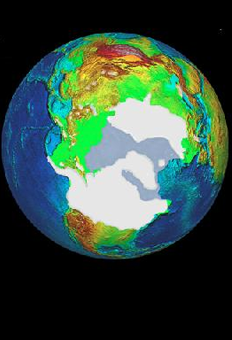NOAA/WDS Paleoclimatology - Lake Żabińskie, Poland 115 Year August Chironomid-Inferred Temperature
This archived Paleoclimatology Study is available from the NOAA National Centers for Environmental Information (NCEI), under the World Data Service (WDS) for Paleoclimatology. The associated NCEI study type is Climate Reconstruction. The data include parameters of climate reconstructions|insect|paleolimnology with a geographic location of Poland, Eastern Europe. The time period coverage is from 54 to -60 in calendar years before present (BP). See metadata information for parameter and study location details. Please cite this study when using the data.
Dataset Citation
- Cite as: Larocque-Tobler, I.; Filipiak, J.; Tylmann, W.; Bonk, A.; Grosjean, M. (2015-11-26): NOAA/WDS Paleoclimatology - Lake Żabińskie, Poland 115 Year August Chironomid-Inferred Temperature. [indicate subset used]. NOAA National Centers for Environmental Information. https://doi.org/10.25921/3xqh-0s44. Accessed [date].
- Please refer to Credit tab for full citation information.
Dataset Identifiers
- doi:10.25921/3xqh-0s44
- noaa-recon-19501
- NCEI DSI 1200_02
- NCEI DSI 1200_01
ISO 19115-2 Metadata
noaa-recon-19501
| Search Data |
|
| Download Data |
|
| Distribution Formats |
|
| Ordering Instructions | Contact NCEI for other distribution options and instructions. |
| Distributor |
NOAA National Centers for Environmental Information ncei.info@noaa.gov |
| Dataset Point of Contact |
NOAA National Centers for Environmental Information ncei.info@noaa.gov |
| Dataset Point of Contact | Data Center Contact NOAA World Data Service for Paleoclimatology 828-271-4800 paleo@noaa.gov |
| Coverage Description | Date Range: 1896 CE to 2010 CE; Date Range: 54 cal yr BP to -60 cal yr BP; |
| Time Period | 1896 to 2010 |
| Spatial Bounding Box Coordinates |
West: 21.9836
East: 21.9836
South: 54.1318
North: 54.1318
|
| Spatial Coverage Map |
| General Documentation |
|
| Associated Resources |
|
| Publication Dates |
|
| Data Presentation Form | Digital table - digital representation of facts or figures systematically displayed, especially in columns |
| Dataset Progress Status | Complete - production of the data has been completed |
| Data Update Frequency | Data update frequency not available |
| Supplemental Information | STUDY NOTES: Chironomid data and August temperature reconstruction from Lake Żabińskie, Poland for the past 115 years. ABSTRACT SUPPLIED BY ORIGINATOR: Chironomids preserved in varved Lake Zabinskie (54 07'54.5"N; 21 59'01.1"E; 120 m a.s.l), northeastern Poland, were used to reconstruct mean-August air temperature since 1896 AD at annual (1949-2011 AD) and at 3-4 year resolutions (1896-1948 AD). This is one of very few studies using chironomids at such high temporal resolution, for a total of 130 sediment samples analyzed. To infer temperature a combined (Northeastern Canada and Poland) transfer function was developed. This transfer function had 112 lakes (50 from Poland, 72 from Canada) and 95 taxa. The mean-August-air temperature gradient was 23.5C. The coefficient of determination (r2jack) was 0.88, the root-mean-square error of prediction (RMSEP) was 1.30C and the maximum bias was 2.08C. The average mean August air temperature measured during the 1961-1990 AD reference period was 16.3C and the chironomid-inferred average temperature for the same period was 16.6C. For the 1981-2010 AD reference period, the temperatures were 1C warmer (i.e. measured = 17.3C; inferred = 17.6C). The differences of only 0.3C between the measured and the inferred temperatures during the reference periods were a first indication that the merged transfer function could provide accurate estimates of mean August air temperature. Chironomid-inferred mean August air temperatures since 1896 AD had strong relationships with instrumental data at near-annual resolution (rPearson = 0.74, pcorr < 0.01). The relationship increased on decadal scale (rPearson = 0.91, pcorr < 0.01) when the errors in varve chronology (-5 to 2 years) were considered. Although the RMSEP of the transfer function was higher than most changes recorded, the average difference between the instrumental and the inferred mean August air temperatures was 0.75C. The results of this study suggest that not only do chironomids reconstruct the right pattern in temperature changes (83% of the inferences recorded the same temperature increase or decrease than the instrumental data) they can also infer changes with the right amplitude (61% of the inferences had differences with the instrumental data below 0.7C). This study is one more example of the possible accuracy of chironomids to reconstruct climate, at least for the past 100 years and at this site. |
| Purpose | Records of past temperature, precipitation, and other climate variables derived from paleoclimate proxies. Parameter keywords describe what was measured in this data set. Additional summary information can be found in the abstracts of papers listed in the data set citations. |
| Dataset Citation |
|
| Cited Authors |
|
| Originators |
|
| Publishers |
|
| Theme keywords |
Global Change Master Directory (GCMD) Science Keywords
|
| Data Center keywords |
Global Change Master Directory (GCMD) Data Center Keywords
|
| Place keywords |
|
| Use Constraints |
|
| Access Constraints |
|
| Fees |
|
Last Modified: 2023-09-01
For questions about the information on this page, please email: ncei.info@noaa.gov
For questions about the information on this page, please email: ncei.info@noaa.gov

